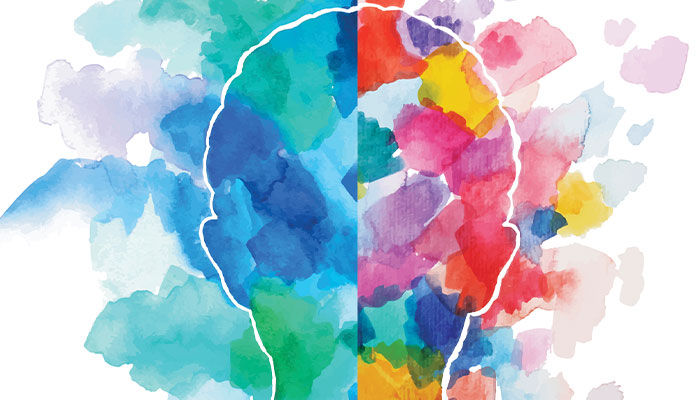Aphantasia is an inability to imagine something visually, and it is believed to affect between one and 5 per cent of the population. (Most of us can also imagine sounds, tastes, textures, any sense essentially.)

Imagine that: Researchers think of aphantasia as an interesting condition, not a clinical one, which doesn't appear to impact lives too much.
Most people, when they imagine for instance a beach scene, will experience seeing the beach in their mind’s eye. Some people have very intense visual experiences, where it feels like they are looking at a photograph; others will see the beach but it might look a bit hazy, or not be in full colour.
When people with aphantasia imagine a beach they think more in concepts; they know what a beach looks like but they don’t actually see a beach in their mind’s eye.
We think of aphantasia as an interesting condition, not a clinical one. It doesn’t appear to impact people’s lives too much – many people don’t realise they have it, or indeed that other people experience visual imagery, until they read about it online or have a discussion with a friend or relative.
Then came the advent of neuroimaging, which showed specific visual areas of the brain were engaged when we imagined things.
Quite often people will say they found out when they went to a yoga meditation and were told to “imagine a beach”, and afterwards they will say ‘that’s ridiculous, you can’t see anything when you close your eyes’, and their friends will say, “It’s not ridiculous, what do you mean?”
While aphantasia is mostly self-diagnosed in this manner, we are trying to find more objective diagnostic tools. In one experiment, we used electrodes to measure people’s skin conductance (essentially how much they sweat) when they imagined scary scenarios, such as being chased by a shark. We found that people with aphantasia didn’t sweat in the same way as people with visual imagery did when they imagined these stories, but when we showed them actual images of scary things, they did.
A debate that raged
Technically we’ve known about the condition since the 1800s. However it wasn’t given a name that stuck until 2015 when UK neurologist Professor Adam Zeman and his colleagues coined it – ‘a’ meaning none, and ‘phantasia’ meaning imagery.

Turning tides: People have said they discovered their aphantasia after being told to "imagine a beach" during yoga meditation.
It likely took so long to name it in part because imagery research was put on the backburner during the behaviourist period in psychology, then when it came to the forefront in the cognitive psychology period, there was a big ‘imagery debate’ from the 1970s to the 1990s.
One group was saying yes, visual imagery is pictorial and we use visual areas of the brain when we imagine; the other group was saying no, it is language-like – we might think we are seeing images but we actually are not.
Even as this debate raged about visual imagery’s very existence, there was research around people who reported they had lost the ability to visualise after suffering a stroke or some form of traumatic brain injury.
The main thing people with aphantasia report that they feel they have ‘missed out on’ is not being able to see loved one’s faces in their minds.
Then came the advent of neuroimaging, which showed specific visual areas of the brain were engaged when we imagined things.
For example, if I showed you a picture of a flower, you would get a pattern of activation in visual regions of the brain. Then when you imagine that flower, you attempt to re-create that neural trace – you reactivate those neurons in a similar pattern to how they were activated when you saw the actual flower.
The idea is that the closer the pattern of neural activity is to when you saw it, the stronger or more vivid your visual imagery is.
A new field of research
There is a lot of research to potentially be done on aphantasia – there are only eight or so research papers to date.

All sorts: Research suggests people with aphantasia tend to gravitate towards STEM jobs, althought it does not stop someone from becoming an artist, says Dr Keogh.
While aphantasia is in itself interesting, visual imagery is involved in a few clinical disorders. In post-traumatic stress disorder, sufferers will have flashbacks that make them relive the traumatic experience in their mind, and people with anxiety report seeing intrusive phobic images popping into their minds over and over again.
Research has shown that these vivid visual experiences make such conditions more stressful and difficult to treat.
A lot of aphantasic individuals (although not all) report to us that they don’t tend to relive traumatic experiences in the same visual way as others, so we are interested in potentially exploring whether people without visual imagery might be immune to PTSD, or experience it differently.
Connections to past and future
So far research suggests that aphantasia might make you more likely to think in analytical ways. A recent paper by Adam Zeman involved a big sample of 2000 people, and found that on average, people with aphantasia tended to be more represented in STEM jobs – in computers, mathematics and so on.
However, aphantasia does not stop someone from becoming an artist. There are aphantasic poets, writers, musicians and artists, and while there are no studies into any specific differences in the creative process of aphantasic and non aphantasic individuals, what I have heard from some of our participants is that they work in a different way; for example when writing a scene, instead of using visualisation in their mind’s eye, they look at pictures to help with their descriptions.
Pros and cons
It is hard to miss something you have never had, but the main thing people with aphantasia report that they feel they have ‘missed out on’ is not being able to see loved one’s faces in their minds, or to imagine and relive past experiences in vivid detail.
But a lot of people also tell me they think it would be awfully distracting to have visual images popping into their head all day, and they also say they feel they live in the present more rather than being stuck in memories of the past, or trying to see what’s going to happen in the future.
- Hackers could bring down our cities – here's how we stop them
- Parramatta heritage goes online in spectacular 3D
In an evolutionary sense, future planning is a big one when it comes to why humans might have visual imagery: the ability to imagine and simulate what might happen means we can ‘future live’ scenarios that can help us make decisions that help us in the future. Remembering things visually from the past can also help us simulate future possibilities.
People with aphantasia do find other pathways to help them remember things and plan for the future; they can still conceptualise what might happen, although it seems that imagining future scenarios could be a little more difficult; more work needs to be done in this very interesting area.
Dr Rebecca Keogh is a cognitive neuroscientist and Research Fellow in the Department of Cognitive Science at Macquarie University.



